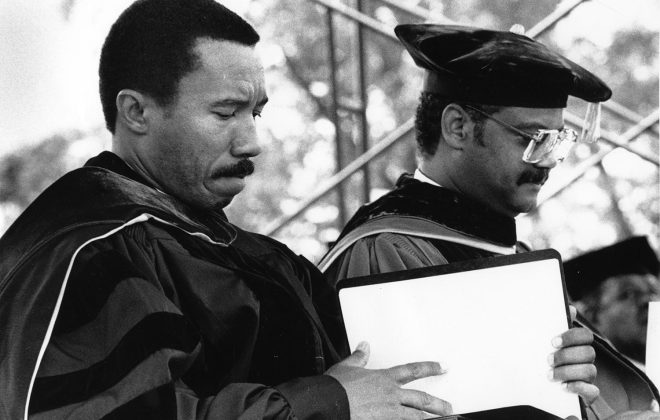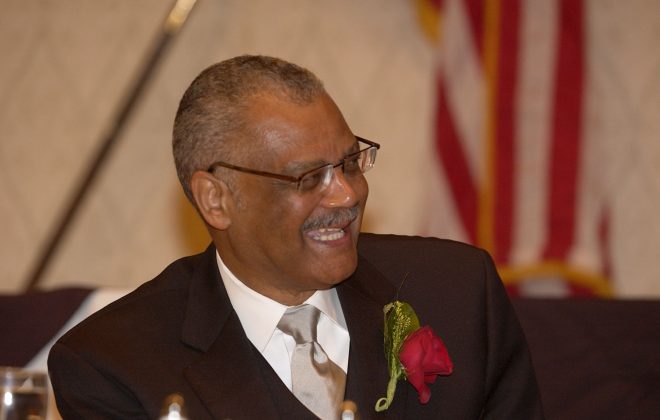Morgan Mourns the Passing of Its Ninth Inaugurated President
Firm on the threshing ground, where truth and honor blend
A happy warrior clad in helmet, armor, and breastplate
For this brave man, the journey does not end.
He seizes a new mission there, where the road bends.
These words, the last stanza of a villanelle by Morgan State University Professor of English Ruthe T. Sheffey, are as fitting now as when they were penned in 2009. The poem honored Earl S. Richardson, Ed.D., as he prepared to retire as president of Morgan after a quarter-century at the post.
On Sept. 12, 2025, President Emeritus Richardson continued his hero’s journey on a higher plane, as news of his passing roiled the University and saddened the broader community of those who benefited from his work across the nation and beyond.
Dr. Richardson took the helm at Morgan in 1984, first as interim president, in February, then as the University’s ninth inaugurated president, in November of that year. For the next 26 years, Maryland’s largest HBCU experienced what became known as the “Morgan Renaissance,” a period of tremendous growth, development and enhancement, in the credentials of its faculty, in its academic programs, in its learning and living facilities, in its impact on the nation’s workforce, in its research conducted, in funds raised to support the mission and in countless other areas.
His brilliance and skill as a communicator and change agent made Dr. Richardson a national leader as well. And his advocacy for equity and funding parity for HBCUs in Maryland — an ultimately successful effort — and for Black higher education institutions nationwide, continued for 11 years after he left the presidency and served Morgan as University distinguished professor and as research associate in the Robert M. Bell Center for Civil Rights in Education.
In his communication about the bereavement to the Morgan community, his successor, Morgan’s current president, David K. Wilson, named Dr. Richardson “a transformative leader in our institution’s history…. His leadership elevated Morgan to the status of a doctoral research institution, expanded academic programs, strengthened faculty excellence and transformed the campus with more than a half-billion dollars in new and renovated facilities.
“Under his stewardship, Morgan’s enrollment grew significantly, the qualifications of incoming students rose, and our graduates went on to excel across every field of endeavor,” Dr. Wilson stated. “Dr. Richardson’s commitment to excellence and his ability to inspire confidence restored faith in the University at a time when its future was uncertain. He leaves behind a legacy of perseverance, innovation and an unshakable belief in the transformative power of education.”
This praise from Morgan’s 10th inaugurated president echoed that from Dr. Richardson’s colleagues 16 years earlier.
“He really brought us to true university status,” said Clara Adams, Ph.D., a Morgan graduate who served as Dr. Richardson’s special assistant to the president and who passed away in August of 2020.
“I had a firm impression of Dr. Richardson because he had a vision, and he was persistent. And he knew that he wanted to establish a quality effort at Morgan, as well as at the engineering school at Morgan,” said Eugene DeLoatch, Ph.D., founding dean of Morgan’s School of Engineering, which was launched in 1984, at the beginning of Dr. Richardson’s tenure as president. “He was someone who was committed to working as hard as the people he chose to work with him.”
“Dr. Richardson had the personality to cultivate the friends who were willing to help us and (the personality) to speak truth to the powers who stood against us,” said Dr. Sheffey.
Viewing the long list of achievements by his administration, it’s easy for current observers to miss the challenges Dr. Richardson and Morgan had to overcome to make them in what later was dubbed “A Remarkable Journey.”
Morgan had experienced “15 years of benign neglect” by funding decision-makers at the state level when Dr. Richardson became president, Dr. Adams recalled for Morgan Magazine in 2009. And “historically Black colleges were viewed by the majority in Congress as entities to be rolled into larger college and university campuses” during Dr. Richardson’s early tenure, said Morgan graduate Kweisi Mfume, now chair of Morgan’s Board of Regents, who was a member of the Board in 2009 and had served as a Maryland congressman for nine years at the time.
“…(Dr. Richardson) was young, a brand new president, had had no experience in being a president, and I think Morgan’s opponents thought that we were going to just self-destruct, that it was just a matter of time,” Dr. Adams recalled. “(But) it didn’t happen. He came in and turned this place around.”
Dr. Richardson fulfilled the pledge he made to Morgan Magazine readers 16 years ago:
“My greatest desire, as always, is to see Morgan’s legacy expand, and I will continue to do all I can toward that outcome, as I have for the past quarter-century.”
And those who knew him expected no less.
“That ability to keep calm in the worst kind of storms, where you think all is lost, to keep an even keel…to not give up,” said Dr. Sheffey. “All of those stories about those heroic leaders give us some substance for talking about Earl Richardson’s career.”
“Morgan is stronger today because of Earl S. Richardson,” President Wilson wrote, “and for that, we are eternally grateful.”
HBCU Hearing: Dr. Earl Richardson
Committee on Education & Workforce Democrats
Dr. Earl Richardson, President of Morgan State University, testifies at a U.S. House of Representatives Committee on Education and Labor hearing concerning Historically Black Colleges and Universities on March 13, 2008.
The Richardson Era at Morgan 1984–2010
- Improved credentialing of faculty —tenure-track faculty holding terminal degrees increased to more than 90%
- Thirty-eight new academic programs added
- Accreditation and reaccreditation of all qualified academic programs
- Designation as a doctoral research institution by the Carnegie Foundation for the Advancement of Teaching
- Renovation of 17 living and learning facilities and construction of 12 new facilities and facilities replacements, totaling more than $500 million
- Increase in enrollment of more than 75%
- Dramatic increase in SAT scores of incoming freshmen
- Growth of more than 1,000% in dollar amount of external grants and research funding
- Successful completion of a capital campaign that exceeded its goal of $25 million in record time
- High state and national rankings in the production of African American graduates
- Outstanding success for graduates, including three of the five African American four-star U.S. Army generals commissioned in the nation’s history
- Graduation of more Fulbright scholars than any institution of comparable size in the U.S.
- Worldwide acclaim for the Morgan State University Choir













